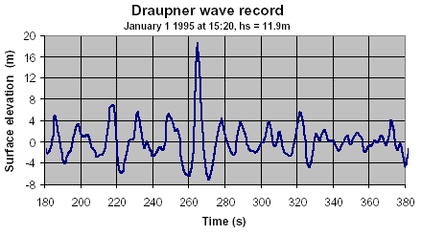
On New Year’s Day, 1995, sailors aboard the Draupner oil rig off the coast of Norway were in for quite the surprise. Instead of fireworks, however, the crew was shaken by an ungodly wave measuring 25 meters (80 feet) in height, seemingly coming out of nowhere.
This phenomenon, known as a rogue or freak wave, had been previously predicted theoretically but the Draupner incident — perhaps a

Now, after almost 25 years of investigations, scientists at Oxford and the University of Edinburgh have finally uncovered the formation dynamics of such monstrous waves.
Inside a test tank at the FloWave Ocean Energy Research Facility in the UK, the researchers generated waves of various amplitudes and frequency, tweaking parameters until they found that a giant wave formed when two waves intersect at exactly 120 degrees. The findings appeared in the
The lab-made Freak Wave was much smaller than the Draupner wave, measuring less than two meters in height. However, seeing how its relative height was double that of the waves that produced it, researchers are confident that the same dynamics are at play in the open sea.
The freak wave generated by the British researchers not only bears a strong resemblance with photos of real freak waves in the ocean but also to “The Great Wave off Kanagawa’ – also known as “The Great Wave’ – a famous woodblock print published in the early 1800s by the Japanese artist Katsushika Hokusai. The artist may have witnessed a freak wave, serving as inspiration for his masterpiece, although there is no evidence to back up such a claim.
The video below shows the freak wave formation process from start to finish.
“Not only does this laboratory observation shed light on how the famous Draupner wave may have occurred
, it also highlights the nature and significance of wave breaking in crossing sea conditions. The latter of these two findings has broad implications, illustrating previously unobserved wave breaking behavior, which differs significantly fromcurrent state-of-the-art understanding of ocean wave breaking,” Prof. Ton van den Bremer at the University of Oxford said in a statement
The 1995 freak wave that hit the Draupner oil rig resulted in minimal damage, but others haven’t been that lucky. Freak waves have caused considerable damage to ships in the past and even fatalities. This is why the researchers hope that their research will lay the groundwork for being able to predict potentially catastrophic waves and issue timely warnings accordingly.


